Glow Green

 Homepage
Homepage 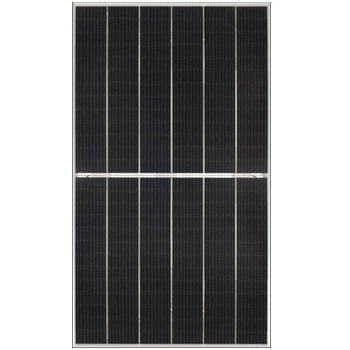

1. Complete a Simple Form
We ask a few questions about your home or business.
2. Pick Your Solar System
One of our friendly account managers will discuss the various options available.
3. Installed by our Experts
We will arrange your installation by one of our professional and friendly local engineers, typically within 2 - 4 weeks - so you start saving sooner!
A typical PV panel offered by Glow Green measures 1722mm by 1134mm, or 1.95m2, generating 430 watts of electricity in standard test conditions. In the UK this STC is determined by a cell temperature of 25°C and an irradiance of 1000 W/m2 with an air mass 1.5 (AM1. 5) spectrum.
Glow Green’s typical sale is of 13 panels, equating to an array of 5.59kWp and requiring a roof space of a little over 25 m2.
A typical semi-detached house, measuring 5 metres wide and 8 metres deep, with a symmetrical gable ended roof at a pitch of 35 degrees would have an available roof space of 35 m2, even after taking into account regulatory distances from the edge of a roof.
This would be split across multiple roofs, as our typical designs are over 2 roofs, to make the most of all available roof space, irrelevant of orientation.
| Property bedrooms | Number of Panels | Panel Size | How many KW | kW/h / kWP | How much energy generated KW/H |
|---|---|---|---|---|---|
| 1 | 4 | 430w | 1.72 | 985 | 1,694 |
| 2 | 6 | 430w | 2.58 | 985 | 2,541 |
| 3 | 8 | 430w | 3.44 | 985 | 3,388 |
| 4 | 12 | 430w | 5.16 | 985 | 5,082 |
| 5 | 14 | 430w | 6.02 | 985 | 5,929 |
| 6 | 16 | 430w | 6.88 | 985 | 6,776 |
Every home and customer is different, but I have chosen at random 2 Key Comparison Tables of designs produced today by our PV Design Team showing the table and it’s contents.
We often see payback periods of 8 years and have seen as low as 3 years. Your electricity usage, time of use and it’s cost per kWh will determine your payback period and the best design and system for you but PV Systems really are one of those investments that start paying back straight away.
| Value | Premium | Ultra | |
|---|---|---|---|
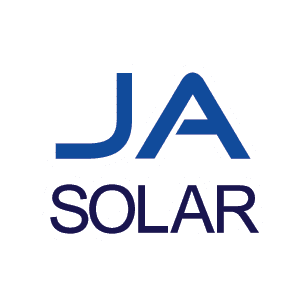 | 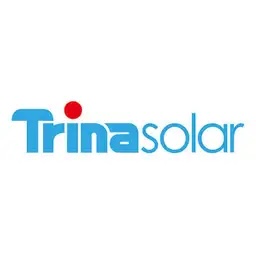 |  | |
| Brand | JA Solar | Trina Solar | Perlight |
| Number of Panels | 14 | 14 | 14 |
| System Output | 5.53kW | 5.74kW | 6.02kW |
| Battery Capacity | 4.80kWh | 5.00kWh | 5.00kWh |
| Panel Warranty (years) | 12 | 15 | 30 |
| Performance Warranty (years) | 25 | 25 | 30 |
| Self Sufficiency (panels only) | 32% | 33% | 34% |
| Self Sufficiency (with battery) | 57% | 60% | 61% |
| Years to Pay Back | 8 | 9 | 9 |
| Total Lifetime Saving | £55,152.00 | £56,158.00 | £57,212.00 |
| Total Cost | £8,486.25 | £9,015.03 | £9,413.77 |
| Value | Premium | Ultra | |
|---|---|---|---|
 |  |  | |
| Brand | JA Solar | Trina Solar | Perlight |
| Number of Panels | 12 | 12 | 12 |
| System Output | 4.74kW | 4.92kW | 5.10kW |
| Battery Capacity | N/A | 5.00kWh | 5.00kWh |
| Panel Warranty (years) | 12 | 15 | 30 |
| Performance Warranty (years) | 25 | 25 | 30 |
| Self Sufficiency (panels only) | 32% | 32% | 34% |
| Self Sufficiency (with battery) | 32% | 60% | 63% |
| Years to Pay Back | 8 | 8 | 8 |
| Total Lifetime Saving | £30,756.00 | £58,711.00 | £59,804.00 |
| Total Cost | £5,356.83 | £8,662.83 | £9,143.02 |
With our typical PV system with a battery costing around £ 8,500, fully installed and commissioned, and the same system without a battery costing just over £ 5,000, there has never been a better time to invest in PV and have you system designed by us at Glow Green.
Our Value package is a brilliant choice for those who fancy saving some coin on their energy bills as well as adding a touch of allure to their property, should they decide to sell it within 5-10 years. With a manufacturing warranty of 12 years and a performance warranty that goes the distance at 25 years (rather smashing, don't you think? I mean, if only our cars came with such guarantees!), this package is absolute value for money that you can't ignore.
Then there's our Premium Range. This one raises the bar with a 15-year manufacturing warranty, complemented by a 25-year performance guarantee. Not too shabby, eh?
Value Package:
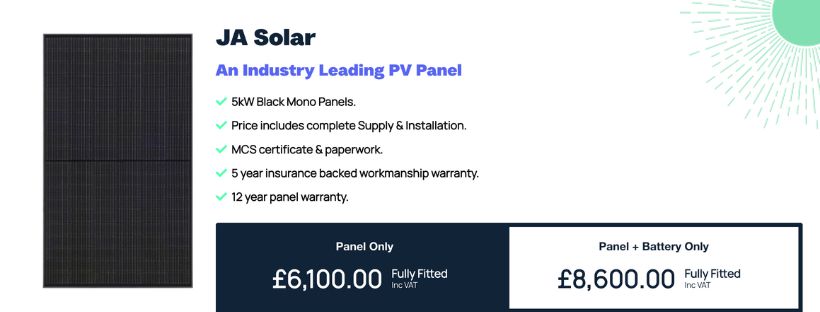
✔️ 5KW Black Mono Panels
✔️ Price Includes Complete Supply & Installation
✔️ MCS Certificate & Paperwork
✔️ 5 Year Insurance Backed Workmanship Warranty
✔️ 12 Year Panel Warranty
| Panel Only | Panel & Battery Only |
|---|---|
| £6,100.00 | £8,600.00 |
| Full Fitted inc. VAT | Full Fitted inc. VAT |
Mid-range Package:
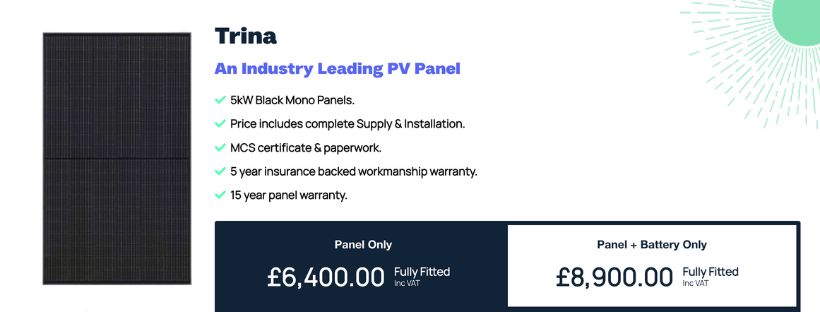
✔️ 5KW Black Mono Panels
✔️ Price Includes Complete Supply & Installation
✔️ MCS Certificate & Paperwork
✔️ 5 Year Insurance Backed Workmanship Warranty
✔️ 15 Year Panel Warranty
| Panel Only | Panel & Battery Only |
|---|---|
| £6,400.00 | £8,900.00 |
| Full Fitted inc. VAT | Full Fitted inc. VAT |
Premium Package:

✔️ 5KW Black Mono Panels
✔️ Price Includes Complete Supply & Installation
✔️ MCS Certificate & Paperwork
✔️ 5 Year Insurance Backed Workmanship Warranty
✔️ 30 Year Panel Warranty
| Panel Only | Panel & Battery Only |
|---|---|
| £6,600.00 | £9,100.00 |
| Full Fitted inc. VAT | Full Fitted inc. VAT |
Now, as much as we'd love to sit down for a cuppa and a chat with each of our potential customers to understand their unique needs, we are aware everyone's racing against time these days.
Therefore, we’ll whip up three different quotes for your first quotation, alongside a nifty 'Key Quote Comparison Summary table'. This handy table not only helps you have a squiz at our quotes side-by-side but also aids you in comparing our offerings with those from other companies.
So, it's a win-win, right?
| Pitched roof System Size | Panel Size | No battery | Pylontech US5000 4.8kWh Battery 48V | GivEnergy 5.2kWh LiFePO4 Battery IP65 | PureDrive PureStorage 2 Battery | Tesla Powerwall 2 |
|---|---|---|---|---|---|---|
| 1KW | 430w | £4,348 | £6,748 | £7,348 | £7,548 | £12,248 |
| 2KW | 430w | £4,655 | £7,055 | £7,655 | £7,855 | £12,555 |
| 3KW | 430w | £4,965 | £7,365 | £7,965 | £8,165 | £12,865 |
| 4KW | 430w | £5,287 | £7,687 | £8,287 | £8,487 | £13,187 |
| 5KW | 430w | £5,765 | £8,165 | £8,765 | £8,965 | £13,665 |
| 6KW | 430w | £6,227 | £8,627 | £9,227 | £9,427 | £14,127 |
| 7KW | 430w | £6,627 | £9,027 | £9,627 | £9,827 | £14,527 |
| 8KW | 430w | £7,298 | £9,698 | £10,298 | £10,498 | £15,198 |
Note: The quoted solar prices in this chart are subject to survey. Factors that can affect the prices include but are not limited to; Scaffolding, Location of property, Property type, Inverter size, Bird Guard, Type of mounting manufacturer and how may roofs the panels are mounted over.
First things first, we use our bespoke design software to sketch out your pitched roof.
We then mark where your gutters are so we can work out which way your roof is tilting.
Not popping up on satellite images? Nothing to worry about! We can get the info we need from things like property planning documents or those sacred title deeds you have stashed away somewhere (you can get these from the HM Land Registry Portal).
Now we've got the postcode and orientation sorted, it's time to figure out the pitch of your roof. This is where building plans or even your architect's drawings come into play.
If they're not at hand (because who keeps hold of those?), we head over to Google Street View or request a snap from you. With an image in tow, we can calculate the exact slope of your roof from the comfort of your home!

Right, here's the thing: we at Glow Green need to figure out just how big your PV system needs to be or could possibly be. Don't fret, it’s easy as pie for us. So we double-check everything with actual building plans or Google Maps.
So, we look at your roof. Measure the width and chalk it down. Then we start looking for any hurdles on your roof. You know, the usual suspects like Velux windows, dormers, chimneys and even those pesky TV aerials.
It’s a bit like playing 'Where's Wally?', but with your roof obstacles.
I’m sure you're wondering, "What if I've done some work on my roof recently?" Is that what you're thinking, buddy? Don't you worry your environmentally-friendly soul!
We’ve got you covered. If we're having a chat, we'll simply ask you.
You can also pop onto our customer portal and drop us some lovely, shiny, new photos of your place. It helps us keep things up to date – just how we like it!
For the width of the roof, a detached property is measured end to end.
For a Semi Detached property, check that both sides are the same width and neither have extensions, and then measure the full width and divide by 2.
For terraced properties, repeat as above but divide by the number of properties in the row.
Measurements from the customer, Building Plans and Screenshots of the measurements are saved so that we can refer back to them later.
With the width measurements completed, we move on to the depth of the roof and placement of these obstacles. Reminiscing back to your time at school, I am sure we all believed that we would never use Trigonometry or Pythagoras' theorem in our daily lives, but we use our maths skills multiple times a day at Glow Green when designing a PV system.
As satellite imagery is taken from above our properties, we cannot just measure the depth of a roof as this will not take into account the roof's trajectory. Where a roof is equal on both sides, symmetrical, like most properties are, you can measure the full depth of the property, divide this measurement by 2, creating a Right-Angled Triangle, making our calculations simple.
As we have the horizontal distance, the “adjacent” length, and its angle, we use this to find our longest sides length (the depth of the roof), “the hypotenuse”.
So for example, the horizontal measurement = 4 and the pitch (Angle A) = 35°, we can use a sine and a tangent to find the hypotenuse and using a calculator, this equals 4.8831.
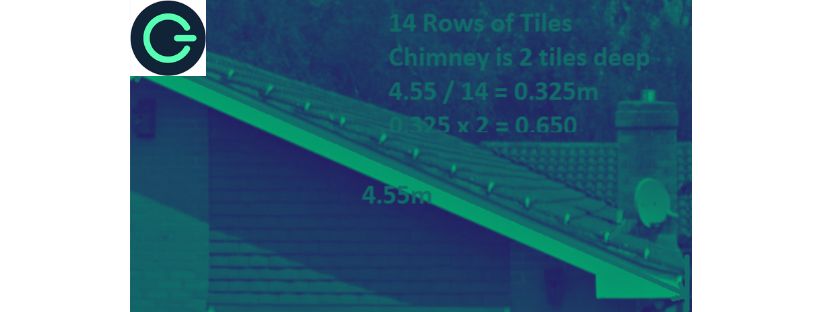
Once we have an accurate width and depth we can move onto creating a scale to notate where any obstacles fall on a roof. As objects on a roof could cause a shadow at times of the day over parts or all of the solar PV array, their placement and size is of the utmost importance when calculating the systems yearly performance later.
We also must ensure that we are leaving appropriate distances from the edges of the roof, around leaded and cemented areas and roof light trims for general maintenance and other Approved Document Building Regulations.
To create a scale, first we need to have a known measurement and then detailed enough pictures to isolate other objects on a roof. For instance, where we now have the depth and width of a roof, if we then count the number of tile rows going up a roof, you can create a scale for obstructions to be placed. If your roof has a depth of 4.55meters, and you can clearly see 14 rows of tiles then: 4.55m / 14 = 0.325m per tile line.
This can then be checked against the standard measurements and overlaps of concrete, slay or slate roof tiles, to double check and ensure you have the correct dimensions and positioning of the roof and its obstacles. Standard measurements of tiles can be found of many building merchant websites and sometimes you can identify the exact tile just from an aerial photo.
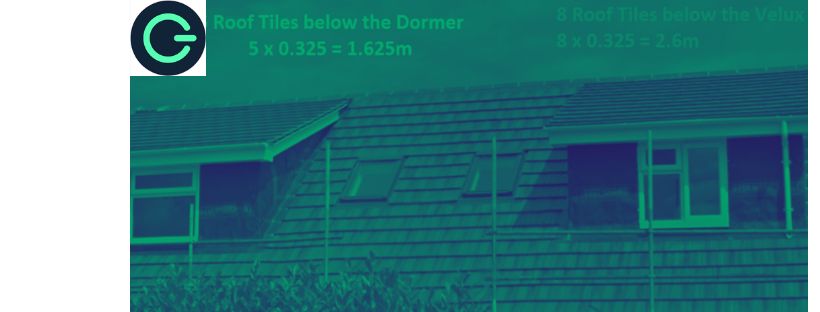
| Minimum Distances | |
|---|---|
| Wind loading - Ridge & Hips | 400mm |
| Wind loading - Gable ends | 400mm |
| Terraced / Semi adjoining roofs | 400mm |
| Valleys and other Lead work | 200mm |
| Velux windows | 200mm |
| Vent Pipes and Flues | 200mm |
| Walls and Dormers | 200mm |
| Chimneys | 200mm |
| Flat Roof System Size | Panel Size | No battery | Pylontech US5000 4.8kWh Battery 48V | GivEnergy 5.2kWh LiFePO4 Battery IP65 | PureDrive PureStorage 2 Battery | Tesla Powerwall 2 |
|---|---|---|---|---|---|---|
| 1KW | 430w | £5,148 | £7,548 | £8,148 | £8,348 | £13,048 |
| 2KW | 430w | £5,455 | £7,855 | £8,455 | £8,655 | £13,355 |
| 3KW | 430w | £5,765 | £8,165 | £8,765 | £8,965 | £13,665 |
| 4KW | 430w | £6,087 | £8,487 | £9,087 | £9,287 | £13,987 |
| 5KW | 430w | £6,565 | £8,965 | £9,565 | £9,765 | £14,465 |
| 6KW | 430w | £7,027 | £9,427 | £10,027 | £10,227 | £14,927 |
| 7KW | 430w | £7,427 | £9,827 | £10,427 | £10,627 | £15,327 |
| 8KW | 430w | £8,098 | £10,498 | £11,098 | £11,298 | £15,998 |
Note: The quoted solar prices in this chart are subject to survey. Factors that can affect the prices include but are not limited to; Scaffolding n, Location of property, Property type, Inverter size, Bird Guard, Type of mounting manufacturer and how may roofs the panels are mounted over.
So, you've got a flat roof? Picture a duck's back after a rain shower, almost horizontal, a slope of less than 10 degrees.
It's not adorned with fancy tiles or slates, but more like a nifty raincoat of torch on-roofing felt, or perhaps a cutting-edge EPDM** Membrane?
You might even be sporting a cool GRP (Glass-Reinforced Plastic), metal, concrete, or even a green roof!
Thanks to our clever tech, we've found these roofs to be just peachy for Solar PV.
For a flat Roof Installation to be viable, we need to confirm the following:
The roof’s pitch is 5 degrees or less
The roof covering is Asphalt, Concrete or EDPM
The maximum Height from Ground is 20 metres
The roof covering is in a good condition
The roof construction is in a good condition and able to take the additional weight of the array and ballast.
The property owner should ensure that the installation of a PV Array does not void any warranties on their flat roof.
The property owner may require planning permission.
We follow the same process to determine the available roof space, but without the theory of Pythagorus for determining the roof size. We do however use it to determine the distance required between each row of panels so that they do not shade each other, reducing the PV Arrays performance.
Firstly though, the Margin required from the edge of the Roof to the first panel must be a minimum of a fifth of the Building Height:
A building height of 3.0m = 600mm (Typical 1 storey)
A building height of 9.0m = 1800mm (Typical 3 storeys)
If the flat roof is surrounded by lower roofs or there is a parapet wall surrounding some edges of the roof, this can lower the distance required. Reputable manufacturers of ballasted flat roof mounting equipment provide online calculators to determine the distances required and the ballast required for the location and exposure of the property and roof.
Van Der Valk and Renusol are 2 companies that provide this service and when accurate information is entered into this calculator we can design a safe and reliable system.
We will always require more information from our customers for these roof types and a structural engineer will always be required to confirm that the roof structure can withstand the additional load a ballasted array imposes.
The main reason we use ballasted arrays though is to ensure the structural integrity and weatherproofing of the flat roof is not compromised for the lifetime of the installed PV system.
Renusol’s PV-Configurator 3.0:
Van Der Valk’s ValkPVplanner:
Ever wondered why we bother prying into your roof type when presenting you with a solar quote? It comes down to the nitty-gritty detail of choosing the perfect mounting system and fixing brackets for a seamless installation.
First off, let's talk about large concrete or clay interlocking tiles. These guys are the popular kids on the block due to their affordability and ease of installation.
How do ya spot ‘em, you ask? Well, just check out the size of the tiles on the gable end of the house and how much they overlap one another.
They’re like tightly linked puzzle pieces, providing you ample protection from the British weather. Each tile snugly interlocks with its neighbour and overlaps the one below without even a hint of shyness.
Then, we've got the Plain Tiles, also known as small tiles or rosemary tiles. They're much smaller and charmingly cute, and do not share the interlocking feature of their larger cousins.
They're typically made from concrete or clay. These modest tiles depend heavily on the chivalrous act of overlapping each other to fend off the rain and wind, covering all the bases: sides, top and bottom.
In our quotes for plain tile roofs, there's always room for something called a Hookstop - essentially a recycled plastic/rubber tile that replaces the tile right beneath the mounting bracket. Clever, huh?
This prevents tile breakages and provides us with a spare roof tile, because, well, accidents do happen!
Finally, let's talk about slate roofs. These are usually spun out of slate or artificial/composite material. Posh? Yes, but also thin, fragile like meringue!
Their overlaps are like a secret handshake, similar to plain tiles but dressed with flashings over the mounting brackets.
When it comes to quoting for slate roofs, we include a Flashing Kit. Picture this as an overzealous bouncer, providing hardcore weather protection at the spot where a slate tile has to make way for the mounting bracket. This device ensures that rain is gracefully ushered away from the roof bracket and the absent slate.
Why the fuss over the roofing material, you wonder? Well, it's critical to nail this at the design stage itself to ensure an installation that's as smooth as butter!
| Ground Mount System Size | Panel Size | No battery | Pylontech US5000 4.8kWh Battery 48V | GivEnergy 5.2kWh LiFePO4 Battery IP65 | PureDrive PureStorage 2 Battery | Tesla Powerwall 2 |
|---|---|---|---|---|---|---|
| 1KW | 430w | £5,548 | £7,948 | £8,548 | £8,748 | £13,448 |
| 2KW | 430w | £5,855 | £8,255 | £8,855 | £9,055 | £13,755 |
| 3KW | 430w | £6,165 | £8,565 | £9,165 | £9,365 | £14,065 |
| 4KW | 430w | £6,487 | £8,887 | £9,487 | £9,687 | £14,387 |
| 5KW | 430w | £6,965 | £9,365 | £9,965 | £10,165 | £14,865 |
| 6KW | 430w | £7,427 | £9,827 | £10,427 | £10,627 | £15,327 |
| 7KW | 430w | £7,827 | £10,227 | £10,827 | £11,027 | £15,727 |
| 8KW | 430w | £8,498 | £10,898 | £11,498 | £11,698 | £16,398 |
Note: The quoted solar prices in this chart are subject to survey. Factors that can affect the prices include but are not limited to; Scaffolding n, Location of property, Property type, Inverter size, Bird Guard, Type of mounting manufacturer and how may roofs the panels are mounted over.
Installing ground mounted solar panels allows homeowners to generate clean energy while avoiding roof limitations. But how much do these systems cost in the UK? Recent quotes show ground mounts ranging from £5,500 to over £16,000 depending on the system size and battery options.
For a basic 1kW setup with no battery, expect to pay around £5,500. This provides four 430w panels on a ground frame, but no energy storage. Adding a battery like the popular Tesla Powerwall 2 jumps the cost to £13,500 for backup power capabilities. Mid-range batteries from GivEnergy or Pylontech add £2,000-4,000 to the overall quote.
As the system size increases, so do the installation costs. A 3kW array with 430w panels and no battery runs around £6,200. Double that to a 6kW system and the price increases to approximately £7,500 without batteries. Large 8kW installations cost £8,500+ for the ground mount and panels alone.
In the end, ground mounted solar can deliver returns but requires upfront investment. Carefully weigh options like system size, panel efficiency, and energy storage to find the optimal balance of performance and affordability.
1. Property type - The type of property you own, whether it's a house or a business, the direction your roof faces, and where your property is in the UK, are important things to think about when getting a solar panel quote. These factors can affect how well your solar system works and how long it takes to pay for itself. You might also need planning permission if your property is in a protected area.
2. Your lifestyle - When does your home use most electricity? If it's mostly at night, adding a battery to store solar power could be a good idea. Other things to think about include how many people live in your home, or if you're working from home during the day. Knowing when you use electricity can help design the best solar power system for your home.
3. Is your roof / ground structurally suitable - Periodically, it may become necessary to involve a structural engineer to evaluate if the framework of your roof or ground can sufficiently sustain the weight of the solar panels along with the associated roof mounting equipment.
4. How much electricity do you currently use? - What is your present consumption of electricity? It's important to match the size of your solar panel system to your yearly power usage. Building an overly large system might generate income through the Smart Export Guarantee (SEG), but if you don't use enough energy, it can prolong the time it takes to recuperate your initial investment.
5. Are you planning on getting an EV or a heat pump? - Thinking about getting an electric car or installing a heat pump in your home? It's best to plan for major electrical work ahead of time. The UK Government wants to stop making petrol and diesel cars by 2035. If you plan to stay in your home for a long time and are thinking about switching to an electric car, it's wise to get a solar panel quote that covers your future needs like powering your heat pump and charging your car.
6. What accreditations does your installer have? - For a reliable PV solar quote, make sure your installer possess these certifications - MCS, HIES, EPVS, NICEIC, and Trustmark.
7. Are there any protections with the PV solar quote? - You should always select a quote from an installer who is a member of EPVS (Energy Performance Validation Scheme) and provides Design Indemnity Insurance. These will guarantee a proper design and offer solutions for any future problems.
8. Does it financially make sense? The key aspects to consider when choosing a solar panel quote are the time it will take to recover your investment and the overall savings you will make over the system's 25-year lifespan.
9. How long are you planning on living at your property? - Considering the duration you intend to stay in your property is crucial. If you plan to live there for a long time, investing in solar panels with a 30-year warranty might be beneficial. Should you decide to sell your house in the future, don't worry. Solar panels can boost its value and appeal, making it more efficient and attractive to prospective buyers.
10. Is there a finance plan included in the quote? - If you're considering this, ensure that your installer has registered with the FCA - Financial Conduct Authority as a credit broker. This can make your payments more manageable, based on your financial situation and affordability.
Good ol' Google Maps and Google Street View, and their buddies Get Mapping and other Satellite mapping chums help us locate most properties.
We also use the Governments and Councils available Planning Portals.
First things first, we need your postcode. Not because we're nosy, but it determines which Irradiance Dataset we'll be using for your Solar PV System Performance Calculation.
Now, don't worry about the fancy words, suffice to say it's a gov standard that measures your postcode's sunny 'performance'.
Done by the big boys at UK's MET Office, and collected over decades, it helps us make an educated guess about how well your shiny new solar panels are going to do.
Moving on, we get down to the nitty-gritty of checking out your rooftop. Are we talking pitched roof, flat roof, even a ground mount?
We've got your back, no matter what your roof's wearing. Ideally, we're looking at a south-facing roof with not much shade - it's like baking the perfect solar PV cake in the northern hemisphere.
But hey, don't despair, even a north-facing roof can produce a fair amount of energy, thank you very much! We'll let our team do the number-crunching, and then it's over to you to decide if the numbers make happy reading!
With the available space determined, we now look at how large a PV Array we can fit on.
In the past because of the Governments Feed in Tariff and regulations, domestically a “4kW system” was always hoped for. Now because systems are cheaper and the industry is more established this approach is not necessarily best. Arrays are smaller, as a 4kW system could be 9 panels now, rather than 16 panels or more as before. Approximately 15 square metres vs 25sqm. Systems can also now be designed to store generated electricity, so often the more the better.
Generally the bigger the system, the more cost effective it is as all of the electricity generated can be used. As an average, the typical home and occupier will use 25% of a PV systems generated electricity at the time of it being generated. The remaining 75% can either be stored in a battery or exported back to the grid to be purchased by your neighbours from their Utility Provider.
Being able to change your time of use of high electricity using appliances will help to make the most of the generated electricity.
A typical PV panel offered by Glow Green measures 1722mm by 1134mm, or 1.95m2, generating 430 watts of electricity in standard test conditions.
In the UK this STC is determined by a cell temperature of 25°C and an irradiance of 1000 W/m2 with an air mass 1.5 (AM1. 5) spectrum.
Glow Green’s typical sale is of 13 panels, equating to an array of 5.59kWp and requiring a roof space of a little over 25 m2.
A typical semi-detached house, measuring 5 metres wide and 8 metres deep, with a symmetrical gable ended roof at a pitch of 35 degrees would have an available roof space of 35 metres, even after taking into account regulatory distances from the edge of a roof.
This would be split across multiple roofs, as our typical designs are over 2 roofs, to make the most of all available roof space, irrelevant of orientation.
As discussed earlier, although a south facing roof with have the highest irradiation level, the main costs associated with a PV system investment are not increased relative to the amount of panels but from a base price which includes the electrical wiring for a new AC circuit, the DC Circuits, an Inverter and other associated components which themselves don’t increase in costs relative to their size either. Due to this, as long as the budget allows, a system will be designed as large as the customer wishes to go.
Once we have done all of the hard work creating the customers property in our design software, creating multiple quotes for our customers is easy and typical. We offer 3 ranges of panels, depending on the expected length of the return on investment and 4 different batteries. We find that most of our customers wish to invest in and stay in their homes for a long time and so bear this in mind to which panel manufacturer they pick.
Our Ultra range comes with a 30 year manufacturing and performance warranty, well above the industry average, which they can give because their manufacturing techniques give them the confidence that their product is going to last for the long term. For homeowners who are in their “forever home”, this is the panel for them, peace of mind that unlike their toasters and tablets, the investment in their chosen PV panel manufacturer won’t stop after a few years.
Way back in 2011, Glow Green, initially a gas boiler installer, dipped its toes into the Solar Panels.
Then, a brainwave! What if we took our entire Solar quotation process online?
Customers snap a few pics, send 'em over, and voila! No expensive Salesman (sorry, 'Surveyor'), no white collar fuel bills.
And just like that, in 2020, the same approach was applied to PV solar quotes.
Our experts don't even need to leave their comfy office chairs to give you an accurate, cost-effective quote, how's that for progress?
At Glow Green, we start by simply having a good ol' chat with the customer. Yep, we want to know your grand plans, your big dreams, and the nitty-gritty details about your property.
We can't just dish out a one-size-fits-all quote for a Solar PV installation. It's all about getting the right fit.
We have a team of in-house Qualified Electricians and Solar PV Experts. These aren't just flashy titles, mind. These folks can tackle the trickiest of questions and design the most mind-boggling of setups.
Listen up, commercial customers! We know your properties have particular needs. Different electricity usage timings, various building designs, and so on.
In fact, our design team is schooled in the art (and science) of Commercial Solar PV design and quotation. Rest easy, we've got you covered.
Now you might be thinking, "So, how do they actually complete a PV Solar Quote?" Good question! Once we’ve broken the ice with a chat, we'll get down to the details...
What type of Property are we quoting for?
Have you had PV before or have you made previous enquiries?
How many people live or work in the property?
Is someone normally at home during the day?
What high usage electricity items do you have, ie an Electric Oven? Electric Shower? Electric Vehicle Charger?
When do you generally use these high electricity using appliances?
Do you expect to change or increase your electricity usage in the future?
Armed with Google Maps and a teaspoon of enthusiasm, we scour satellite images to find and assess your property in just a couple of shakes of a lamb's tail.
Sound good? Well, hold onto your hats because it only gets better from here.
Over the years, we've tucked tens of thousands of PV installations under our belts, making us as trusty as your favourite pair of jeans.
First off, we've received thumbs up from the NICEIC, which in the world of electrical is like being knighted by the Queen.
Then, there's the MCS, giving us a shiny badge of quality assurance in renewables. MCS-certified badge also means we can help you with SEG agreements (yes, those Smart Export Guarantee things!) that your utility company is likely to have you register for.
Plus, we've got relationships brewing with all the DNOs and iDNOs (those are the folks who manage district and independent network operations, in case you were wondering).
So, we're able to sprint through the red tape of generator applications and PV system commissioning forms like an Olympic athlete.
All thanks to our flawless understanding of ENA’s (Energy Networks Association) and the Government's guidance. Goodbye tedious paperwork and hello smooth installations.
Oh! Can't forget our memberships with HIES and RECC, who both make sure we're leading the charge in customer care and quality.
Finally, let's not forget that Glow Green was dreamt up and is being run by qualified engineers who really know their stuff. We want to assure you that we genuinely care, and we're bent on offering top-tier industry standards in our designs, quotes, and installations.
As part of this process, you receive a link to upload a list of photographs that will help us ensure we design the best PV system for you. We ask for:
Please upload a Copy of your Utility Bill
Is your property, or an extension to it, less than 5 years old? If Yes - Please upload copies of your Building Plans
Are any of the Roofs we’re installing PV Panels on, Flat Roofs? If Yes - Please take photos of the depth of the Roof Joists from inside and from the Outside
Please supply a photo of your Electric Meter and its surroundings
Please supply a photo of your consumer unit (fuse board) with the lid open
Please supply a photo of your consumer unit (fuse board) showing its surroundings
Please supply a photo of the access to your loft space
Please supply photos of the inside of your loft space
Please supply photos of the roofs that the PV panels are to be mounted on
Please supply photos of the ground below the roofs that the PV panels are to be mounted on
Please supply photos of any trees, or shading issues that cast a shadow on the roof
Please supply a photo of where you would like the inverter and battery to be located
Other specific photo requirements might be discussed with customers but the above photos would normally mean that we can ensure the accuracy of design / PV Solar quote and suitability of a PV system.
At Glow Green PV solar quotes are valid for 14 days as our aim is to secure our customers the very best products and the UK’s leading prices. There are many market factors that mean we can only hold PV solar quotes for 14 days,
The technology is always evolving and we want to provide cutting edge technology to our customers as products evolve.
Prices can move up and down like a rollercoaster. This is due to Shipping cost from China, FOREX rates, and the cost of Raw materials used in the manufacturing process.
The Global Demand - We did see lots of stock shortages through 2021 and 2022. At Glow Green we own a 17.000 SQ/FT warehouse and hold over £4,005,250 GBP in stock.
Wholesale energy Market, which as we have seen in the UK ( and around the world) has been very vulnerable.
References
You can get an instant solar quote by completing our simple online form. One of our expert and friendly solar account managers will contact you. We can provide you with a quote remotely, without the need for a home visit. No need for an expensive surveyor to come to your home, drink your tea and eat your biscuits! At Glow Green, to provide you with a solar quote, we use our bespoke cutting-edge quote tool to give you a 100% fixed price quote.
We can give you an instant estimate in 60 seconds, so you can get an idea of the price. One of our friendly solar account managers will then contact you to complete the remote quote and design. This usually takes 20 minutes to complete the fact-finding, then we can build the design. We need to ask you a few questions about your lifestyle and energy usage to build a bespoke system that works for your lifestyle and budget!
Yes, Glow Green is an FCA regulated credit broker (not the lender) and we can offer you finance packages. We have a low monthly finance plan so you can spread the cost over 10 years.
We also offer a Buy Now, Pay Later (BNPL) option. BNPL offers the ability for customers to pay the balance of their PV solar installation over a 6-month period without paying any interest on the borrowed amount.
First, a 10% deposit is required. We can then submit an application on your behalf which, if approved, means you could have the solar and battery system installed and pay nothing for up to 6 months, provided the full loan balance is repaid within that period. There are no interest or exit fees for you to pay and no restrictions on how much or how often you make payments.
Only if the full balance is not repaid during the BNPL period will the remaining amounts become due under a 60-month interest-bearing finance plan at 19.9% APR (representative), with equal payments taken by the lender via Direct Debit.
Any credit is subject to application, financial circumstances and borrowing history.
Once you've completed the online form, we'll e-mail you everything you need. From there you will be able to accept your quote and have your panels installed in as soon as 2 weeks!
Yes, you can refer a friend for a solar quote. Glow Green allows you to earn money by referring people to our services.
Glow Green Solar quotes are 100% fixed prices. The quote will include a detailed design and itemised breakdown of costs.
Glow Green offer a price beat guarantee, as long as the comparison is for a like-for-like KW and battery storage system.
In the UK, the typical break-even time for solar panels is 8 to 12 years. However, this depends on the size of your solar panel system, the export tariff, your energy consumption, and electricity prices.
There are several reputable solar panel manufacturers available in the UK, including Perlight, Jinko Solar, SunPower, JA Solar, Suntech, and Project Solar. You can find out more about the best solar panels, here.